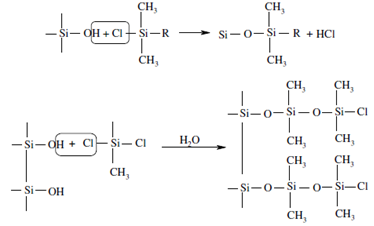Partition Chromatography:
It can be subdivided into liquid-liquid chromatography (LLC) and bonded phase chromatography (BPC), the difference being in the method by which stationary phase is held on the support particles of the packing. In case of LLC, a liquid stationary phase is retained on the surface of the packing by physical adsorption. Along with bonded phase, a stationary phase is bonded chemically to the surface of inert support. An of late bonded phase has become predominant over liquid phase because of certain drawback. A packing for bonded phase are prepared from rigid silica or silica based compositions. These are formed as uniform, porous, mechanically sturdy particles generally having diameters 3, 5 or 10 µm. The surface of fully hydrolysed silica is made up of chemically silanol groups. The most meaningful bonded phase coatings are siloxanes formed through the reaction of hydrolysed surface with an organochlorosilane as shown below:

Surface coverage by silanization is limited to 4 µmol/m2 or less because of steric effects. The unreacted SiOH groups impart an undesirable polarity to the surface, which may lead to chromatographic tailing of the peaks. In order to avoid this effect, siloxane packings are often capped by further reaction with chloromethylsilane that can react with many of the unreacted silanol groups.